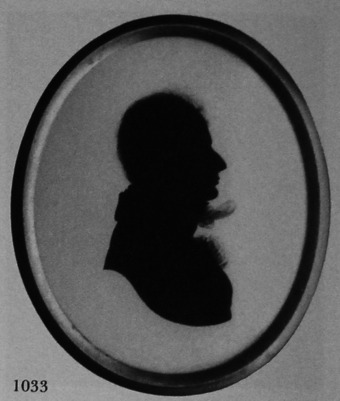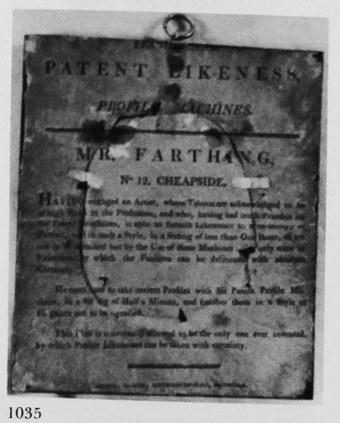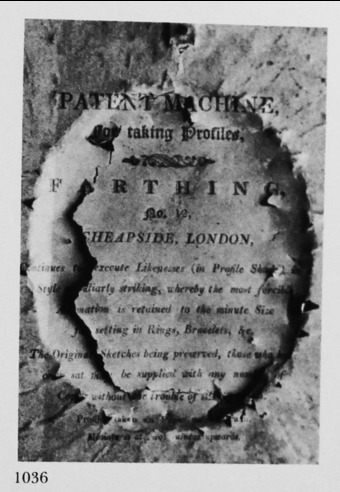Farthing, William (McKechnie Section 3)
See also Sections Two, Four, Five and Six
Recorded by Jackson (Dictionary), at a time when the artist's first name was not known. Recent research has shown that Farthing was a man of many parts, probably not a silhouette artist himself but a dealer who sold silhouettes, painted on various surfaces, as only one among a variety of occupations. He lived and worked at 12 Cheapside, London, from about Michaelmas 1797 until the autumn of 1807. This address was in the parish of St Vedast, Foster Lane, and London directories contain entries for it for the years 1798-1805. In these entries Farthing is variously listed as jeweller, goldsmith or 'pocket-book maker'. From the St Vedast Parish records (Harleian Society transcripts) we know that Farthing and his wife Jane had four children: Charlotte, born in 1799; Elizabeth, born in 1801; James, who, born in 1803, died aged four months old; and John, born in 1805.
The records also state that Farthing was church-warden at St Vedast in 1803. The rate books for this parish during this period are missing, but lists of inhabitants and periodic rosters are available for a few years, and Farthing's occupation as a church-warden is mentioned in these. We know from similar sources of information that Henry Hervé I (see Section Two) occupied the house during Christmas 1807, and we can therefore assume that Farthing's tenure had ceased by this date.
On one of his trade labels Hervé refers to himself as `Successor to Mr. Farthing'. We are also told, on Farthing's Trade Label No. 1, that Farthing has `engaged an artist', and it seems almost certain that this artist was Henry Hervé I (especially since work on glass, backed by Hervé's labels, is very similar in style to that backed by Farthing's labels). Moreover, miniatures (which we know that Hervé was capable of painting) are offered on Farthing's Trade Label No. 2.
Farthing's Trade Label No. 1 tells us that he had acquired one of Isaac Hawkins's Patent Machines for the use of his artist. Farthing was at 12 Cheapside for about ten years, but, to judge from the appearance of the scanty extant work bearing his labels, he probably did not acquire the machine until after c. 1804. When Farthing left the premises at the end of 1807, and Henry Hervé occupied them, Hervé probably bought from Farthing the model of the machine which Farthing had owned.
In considering the type of work produced under Farthing's name, we must bear in mind that it was created by an artist (probably Henry Hervé) who was in his employment. It is evident from Farthing's Trade Label No. 1 that the basic outlines of the silhouettes were mechanically produced. The backing of a so-called 'Farthing' silhouette on glass is of the same kind as that of a silhouette on glass by Hervé: it is made of a distinctive, buffish-pink composition, filling in the whole of the back of the convex glass, on the under surface of which the silhouette is painted.
No detail is shown on the body of the profile, but some transparency is apparent in the painting of the shirt-frill and cravat; this is of a slightly brownish hue. Further brushwork is shown outside the outline of the head, to indicate the popular à la Titus hair-style of the time. The work is not quite so meticulous as that on the plaster profile, bearing Farthing's trade label, illustrated in Section Four. The bust-line termination follows a simple convexity/concavity line. On profiles of men some width is shown at the base, though less than on examples backed with Hervé's labels, since these were painted at a time when men's tail-coats were particularly wide at the shoulder. One would expect 'Farthing' silhouettes on glass to be framed in papier mâché, or (like the example discussed below) in oval pearwood frames.
One unlabelled example is illustrated. If Hervé was indeed employed by Farthing, this is likely to have been painted before 1807 and probably originally bore one of Farthing's trade labels. The shape resembles that seen on Hervé's cut work more than that seen on any other silhouette on glass backed with one of either Farthing's or Hervé's labels.
On both his trade labels Farthing states prominently that silhouettes from his studio are produced with the aid of mechanical devices, named on Trade Label No. 1 as 'Hawkin's Patent Likeness and Profile Machines'. This machine, which was probably of the physiognotrace type and was used for the production of hollowcut bust-length silhouettes, was invented by John Isaac Hawkins, who is believed to have settled in Philadelphia in 1802. Possibly he appointed an agent to supervise the sale of the machines in Britain (where they were presumably manufactured under a patent) after his departure. William Bullock (see Appendix Four) devised a similar machine, and C. Stanley (q.v.) probably devised another. In the United States Charles Wilson Peale (see Appendix Five) instituted a sideshow at the Museum and Art Gallery which he had founded in Philadelphia in 1775, in which the machine was manipulated by Peale's black slave, Moses Williams, to produce silhouettes. Whether Hawkins presented Peale with one of the machines, or Peale acquired from Hawkins the rights to use one, is unknown.
Of Farthing's two trade labels, No. 1 was probably used c. 1804-1806. It reads thus:
HAWKIN 'S
PATENT LIKENESS
AND
PROFILE MACHINES
MR. FARTHING
No. 12, CHEAPSIDE
Having engaged an Artist, whose talents are acknowledged to be of high rank in the Profession, and who, having had much Practice on the Patent Machines, is able to furnish Likenesses of a certainty so Perfect, and in such a Style, in a Sitting of less than one Hour, as are not to be obtained but for the use of these Machines; the only ones in Existence by which the Features can be delineated with absolute certainty. He continues to take correct Profiles with his Patent profile Machine, in a sitting of Half a Minute, and finishes them in a Style of elegance not to be equalled.
The plan is universally allowed to be the only one ever invented by which Profile Likenesses can be taken with certainty.
Sorrell, Printer, Bartholemew- Close, Smithfield.
Farthing used Trade Label No. 2 later (probably c. 1806-1807), while living at 12 Cheapside:
PATENT MACHINE
For taking Profiles
FARTHING
No. 12,
CHEAPSIDE, LONDON
Continues to execute Likenesses (in Profile Shade) in a Style peculiarly striking, whereby the most forcible Animation is retained to the minute Size for setting in Rings, Bracelets, &c.
The Original Sketches being preserved, those who have once sat may be supplied with any number of Copies without the trouble of sitting again
Profiles taken on paper 2s. 6d. each
Miniatures at Two Guineas upwards.
Ills. 1033-1036

Unknown man
Silhouette painted on convex glass, backed with buffish-pink composition
c. 1806-1807
3¼ x 2½in./83 x 64mm.
Trade Label No. 2
Frame: papier mâché
Jean Lapworth collection

Unknown man
Silhouette painted on convex glass, backed with buffish-pink composition
c. 1806
3½ x 2½in./90 x 64mm.
Frame: oval, turned ebonised wood
Although unlabelled, this silhouette can, on stylistic grounds, be attributed to Henry Hervé I; its plain style suggests that it dates from the period when Hervé was working for Farthing.
J. A. Pollak collection

Trade Label No. 1 of William Farthing, from a silhouette illustrated in Section Four (1252).
T- E. F. Sainsbury collection

Trade Label No. 2 of William Farthing, from a silhouette illustrated in 1033.
Jean Lapworth collection
